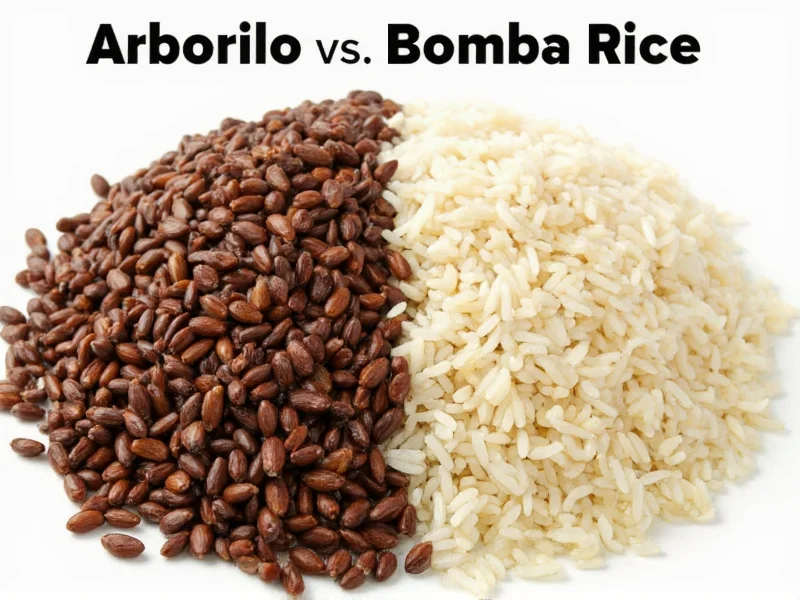When choosing between arborio vs bomba rice, understanding their unique properties helps you select the right grain for your culinary creation. Both varieties serve as premium short-grain rices in traditional dishes, but their structural differences significantly impact cooking results. This comprehensive comparison examines their characteristics, optimal uses, and substitution possibilities to help home cooks and professional chefs make informed decisions.
Understanding Arborio and Bomba Rice Origins
Arborio rice originates from the Po Valley in Italy and remains the most widely available risotto rice globally. Its namesake comes from the town of Arborio in the Piedmont region. Bomba rice, sometimes called Valencia rice, hails from eastern Spain and has been cultivated in the Albufera lagoon area near Valencia since the 15th century. While both are short-grain varieties, their genetic differences create distinct cooking behaviors that chefs leverage for specific dishes.
Physical Characteristics Comparison
The visual and structural differences between these rices explain their varying performance in cooking. Examining their physical properties reveals why certain dishes require specific varieties.
| Characteristic | Arborio Rice | Bomba Rice |
|---|---|---|
| Grain size | Large, oval-shaped (5-6mm) | Shorter, rounder (4-5mm) |
| Starch content | High (18-20%) | Moderate (14-16%) |
| Absorption capacity | Moderate (3-4x water) | Exceptional (up to 3x its volume) |
| Cooking time | 18-20 minutes | 20-25 minutes |
| Texture when cooked | Creamy exterior, slightly firm center | Firm throughout, distinct grains |
Culinary Applications: Where Each Rice Excels
Professional chefs select rice varieties based on desired texture outcomes. The structural differences between arborio vs bomba rice make them suited for specific traditional dishes.
Arborio Rice: The Creamy Risotto Specialist
Arborio's high starch content creates the signature creamy texture essential for authentic Italian risotto. As the grains rub against each other during constant stirring, they release starch that emulsifies with broth and fat. This process creates a luxurious mouthfeel without requiring additional thickeners. However, arborio's structure means it can become mushy if overcooked or if cooking stops prematurely before the starch fully develops.
When preparing arborio for risotto, maintain a gentle simmer and add warm broth gradually. The ideal finished texture features al dente grains surrounded by a creamy sauce that flows slowly when plated—a characteristic Italians call all'onda (wavy). Many home cooks wonder can I substitute bomba rice for arborio in risotto? While possible, bomba won't create the same creamy consistency due to its lower starch content.
Bomba Rice: The Paella Perfectionist
Bomba's unique structure makes it the undisputed champion for authentic Spanish paella. Its ability to absorb liquid without becoming soft allows each grain to remain distinct while soaking up saffron-infused broth and other flavors. Unlike arborio, bomba maintains its integrity even when cooked with the high liquid ratios paella requires.
Professional paella chefs appreciate bomba's forgiving nature—it tolerates slight timing errors better than other rices. The prized socarrat (caramelized crust at the pan's bottom) forms beautifully with bomba because the grains don't break down prematurely. When considering arborio vs bomba rice for paella, bomba consistently produces superior results with its characteristic firm bite.
Availability and Substitution Guidance
Understanding where to find these rices and when substitutions work prevents recipe failures. Their availability differs significantly outside their native regions.
| Factor | Arborio Rice | Bomba Rice |
|---|---|---|
| Global availability | Widely available in supermarkets | Specialty stores or online |
| Price (per pound) | $3-5 | $6-10 |
| Best substitution for | Carnaroli or Vialone Nano | Sena or Albufera varieties |
| Acceptable substitute | Yes (for bomba in paella) | Limited (for arborio in risotto) |
Practical Cooking Tips for Optimal Results
Mastering these rices requires technique adjustments beyond simple substitution. Each variety responds differently to cooking variables.
Arborio Rice Cooking Protocol
- Use a 3:1 broth-to-rice ratio for standard risotto
- Maintain constant gentle stirring to release starch
- Add warm broth gradually (½ cup at a time)
- Finish with cold butter and grated Parmesan for enhanced creaminess
- Avoid overcooking—grains should retain slight resistance
Bomba Rice Cooking Protocol
- Use a 3:1 liquid-to-rice ratio for paella (higher for soupy variations)
- Minimize stirring to preserve grain integrity
- Add all liquid at once for traditional paella preparation
- Allow proper resting time (5-10 minutes) before serving
- Never rinse bomba rice—starch is essential for texture development
Storage and Shelf Life Considerations
Both rices maintain quality when stored properly, but their different structures affect longevity. Keep uncooked rice in airtight containers away from light and moisture. Arborio typically remains fresh for 6-12 months, while bomba's denser structure allows 12-18 months of optimal quality. Refrigeration extends shelf life but requires careful moisture control. Cooked leftovers freeze well for up to three months when properly sealed.
Final Recommendation: Choosing Between Arborio vs Bomba Rice
Select arborio when creating creamy Italian dishes like risotto, rice pudding, or supplì (fried rice balls). Choose bomba for Spanish paella, arroz negro, or any dish requiring distinct, firm grains that absorb substantial liquid. While substitutions sometimes work in a pinch, understanding arborio vs bomba rice differences ensures authentic results. Serious enthusiasts maintain both varieties in their pantry for recipe-specific applications, recognizing that the right rice makes the dish.











 浙公网安备
33010002000092号
浙公网安备
33010002000092号 浙B2-20120091-4
浙B2-20120091-4